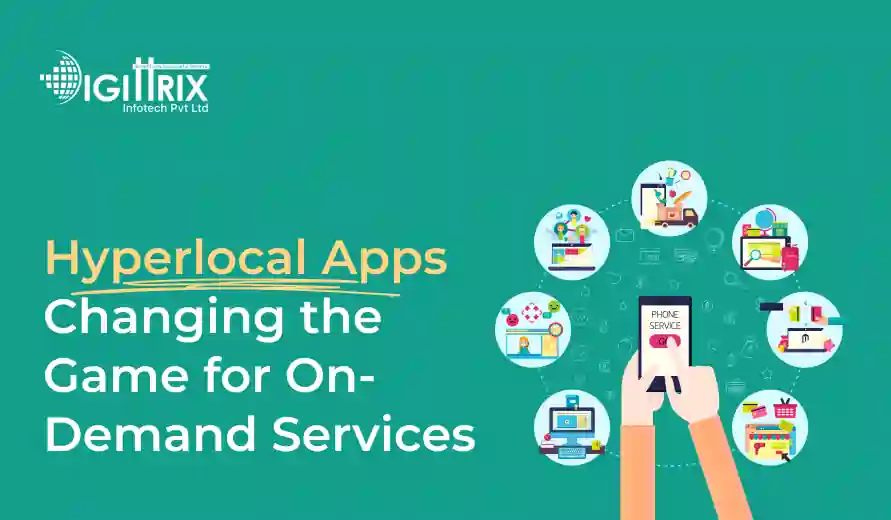Hyperlocal apps are transforming how people access daily services, providing faster deliveries, connecting communities, and supporting local businesses through quick, efficient, and accessible digital platforms.
Highlights
An enthusiastic developer and skilled business management expert with over a decade of experience in the field

The way people buy products, order groceries, book cabs, or access neighborhood services has evolved considerably in recent years. Today, consumers prioritize convenience, immediacy, and local access to services. This is where hyperlocal apps come into play. By connecting users with nearby businesses or service providers, these apps have become an essential part of daily life life.
Hyperlocal apps operate within a specific geographic area. They connect customers to local merchants, delivery partners, or service providers, making transactions faster and more convenient. Whether it's food delivery, online pharmacy services, grocery shopping, or booking a plumber, hyperlocal apps have transformed how on-demand services are accessed.
This detailed article examines the concept of hyperlocal apps, their advantages, the industries that utilize them, market challenges, and why they have become a vital part of modern service ecosystems.
Want to understand the future of hyperlocal apps? Check out Digittrix’s guide on how hyperlocal apps are transforming businesses today!
Hyperlocal apps are platforms designed to deliver goods or services within a small geographic area, usually a city or town. Unlike large e-commerce platforms that may serve customers from warehouses located far away, hyperlocal apps emphasize quick delivery. They connect consumers with local stores, restaurants, service providers, and logistics partners.
The entire system is based on quick accessibility. For example, when you order groceries through a hyperlocal delivery app, the items come from a store near your home instead of a distant distribution center. This approach cuts delivery times and improves the overall customer experience.
The rise of hyperlocal services is mainly driven by changing consumer habits. Today’s consumers don’t want to wait days for an order. Instead, they want groceries in minutes, medications within hours, or services on the same day. Hyperlocal apps meet this demand by providing:
This model has opened new opportunities for small businesses while simplifying life for customers.
For hyperlocal apps to operate smoothly, they depend on specific features that make the user experience simple and efficient.
These features together foster an experience that promotes repeated use and customer loyalty.
Several industries have gained from the growth of hyperlocal applications. Each sector has embraced the model in its own distinct way.
Courier companies use hyperlocal platforms for faster deliveries, especially for same-day or express shipping needs.
Hyperlocal apps have given small and medium-sized businesses a platform to compete with larger brands. Local vendors can list their products or services on these apps and immediately gain access to a larger customer base.
Some clear benefits include:
Technology is central to the success of hyperlocal apps. Features such as GPS tracking, AI-powered suggestions, and secure payment options enhance their functionality and user experience.
A well-designed hyperlocal app relies heavily on advanced software solutions and skilled professionals. Businesses often seek hyperlocal app development experts to create platforms that are scalable, user-friendly, and equipped with essential features. In fact, investing in on-demand hyperlocal app development enables companies to connect their services with local customers quickly and efficiently.
For brands aiming to target mobile users, choosing between Android and iOS development is crucial. Many companies hire either an Android App Developer or an iOS App Developer to create apps for their specific audience. Depending on the region, one platform may have more users than the other, leading businesses to often develop for both ecosystems.
The smartphone is the key device for hyperlocal apps. Nearly every transaction, from ordering groceries to booking a ride, takes place on mobile devices. This makes mobile app development essential for companies looking to enter the hyperlocal market.
With smartphones reaching every part of society, hyperlocal apps become the link between businesses and consumers. Companies providing app development services recognize this demand and create apps that make user journeys easier, improve performance, and help businesses grow. For many startups, working with a mobile app development company is the first step to entering the on-demand economy.
Despite their success, hyperlocal apps encounter some challenges that require focus.
The hyperlocal model is expected to strengthen in the future. As demand for faster services grows, along with the increasing use of smartphones and better logistics networks, hyperlocal apps will keep leading on-demand industries.
Emerging technologies like AI, voice assistants, and predictive analytics will make hyperlocal services smarter and more efficient. Local businesses will increasingly depend on these apps to stay competitive and connect with modern consumers consumers.
Furthermore, as more people choose online shopping, hyperlocal services will become a necessity instead of an option. Businesses that do not adopt this model may lose customers who value convenience and quick service.
Curious about backend options? Check out Digittrix’s insights on the best backend frameworks for mobile apps to choose what works best!
Hyperlocal apps are no longer just a trend—they have become a vital part of the on-demand service ecosystem. From food and groceries to healthcare and home services, these platforms connect people with local businesses like never before before.
The growth of hyperlocal apps has also opened new opportunities for businesses, providing them with advanced digital tools and access to larger markets. Companies aiming to enter this space must focus on developing robust digital solutions with the help of hyperlocal app development experts. Involving specialists in on-demand hyperlocal app development ensures these platforms meet customer needs while supporting local businesses.
In the coming years, hyperlocal apps will continue to transform how people access goods and services nearby. Their role in linking communities with local vendors is not just about convenience but also about fostering a sustainable, connected future for local economies.
Hyperlocal apps are changing how customers connect with nearby vendors and service providers. If you’re planning to launch your own hyperlocal service platform, Digittrix can help bring that vision to life.
We develop high-performance, user-friendly solutions that focus on speed, security, and precise location services. Using advanced technologies like Flutter, Node.js, and Firebase, our team creates apps for Android, iOS, and web platforms that deliver smooth and efficient user experiences.
From food delivery and grocery shopping to on-demand home repairs and local markets, we develop apps that include all the essential features customers expect—real-time location tracking, vendor and order management, instant payments, and detailed service history.
With over 14 years of experience in mobile app development and on-demand hyperlocal app solutions, Digittrix understands the unique challenges of this growing market. Our solutions are designed to help you effectively serve your target community and stay competitive in the on-demand sector economy.
Get started today! Call us at +91 8727000867 or email digittrix@gmail.com to schedule a free consultation with our development experts.

Do you need help in Mobile App development?




Join over 1500+ businesses we've already helped!
A hyperlocal app connects users with nearby stores or service providers to deliver products or services quickly within a small area.
They are widely used in food delivery, grocery shopping, pharmacy services, home maintenance, and quick courier deliveries.
They save time, reduce waiting for deliveries, and make it easy to access essential services within the same neighborhood.
They are created using mobile technology that allows real-time tracking, digital payments, and smooth connections between users and providers.

©2025Digittrix Infotech Private Limited , All rights reserved.